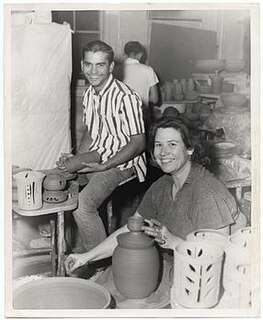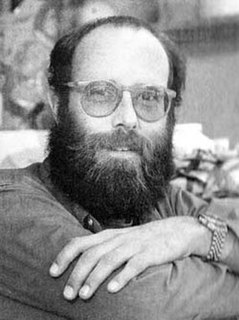Related Research Articles

Raku ware is a type of Japanese pottery traditionally used in Japanese tea ceremonies, most often in the form of chawan tea bowls. It is traditionally characterised by being hand-shaped rather than thrown, fairly porous vessels, which result from low firing temperatures, lead glazes and the removal of pieces from the kiln while still glowing hot. In the traditional Japanese process, the fired raku piece is removed from the hot kiln and is allowed to cool in the open air.
Paul Edmund Soldner was an American ceramic artist and educator, noted for his experimentation with the 16th-century Japanese technique called raku, introducing new methods of firing and post firing, which became known as American Raku. He was the founder of the Anderson Ranch Arts Center in 1966.

Peter Voulkos was an American artist of Greek descent. He is known for his abstract expressionist ceramic sculptures, which crossed the traditional divide between ceramic crafts and fine art. He established the ceramics department at the Los Angeles County Art Institute and at UC Berkeley.
Peter Hayes is a contemporary sculptor now based in Bath, England, whose work is displayed in public locations including the UK, US, Canada and Belgium.

Studio pottery is pottery made by professional and amateur artists or artisans working alone or in small groups, making unique items or short runs. Typically, all stages of manufacture are carried out by the artists themselves. Studio pottery includes functional wares such as tableware and cookware, and non-functional wares such as sculpture, with vases and bowls covering the middle ground, often being used only for display. Studio potters can be referred to as ceramic artists, ceramists, ceramicists or as an artist who uses clay as a medium.
D. Wayne Higby is an American artist working in ceramics.
John Mason was an American artist who did experimental work with ceramics. Mason's work focused on exploring the physical properties of clay and its "extreme plasticity". One of a group of artists who had studied under the pioneering ceramicist Peter Voulkos, he created wall reliefs and expressionistic sculptures, often on a monumental scale.

Ralph Bacerra was a ceramic artist and career educator. He lived and worked in Los Angeles, California.
Regis Brodie is a tenured Professor of Art at the Department of Art and Art History at Skidmore College in Saratoga Springs, NY and a potter. Since 1972, he has been serving as the Director of the Summer Six Art Program at Skidmore College. He also wrote a book called The Energy Efficient Potter which was published by Watson-Guptill Publications in 1982. He started the Brodie Company in 1999 in the interest of developing tools which would aid the potter at the potter's wheel.

Robert Brady (1946–present) is an American modernist sculptor who works in ceramics and wood. Born in Reno, Nevada, he has made his home in the San Francisco Bay Area for many decades. Brady is a multi-faceted artist who works in ceramics, wood, painting, and illustration, and is best known for his abstract figurative sculptures. Brady came out of the California Clay movement, and the Bay Area Arts scene of the 1950s and 1960s, which includes artists such as Peter Voulkos, Viola Frey, Stephen de Staebler, and Robert Arneson who was his mentor and teacher in college.

Rudolf Harry "Rudi" Staffel was an American ceramic artist and educator.
Kirk Mangus (1952–2013) was an internationally renowned ceramic artist and sculptor "known for his playful, gestural style, roughhewn forms, and experimental glazing". His murals, works in clay, on paper, in wood, and other media pull from a rich and diverse set of influences: ancient Greco-Roman art, mythology, Japanese woodblock prints, comic books, folk stories, from Meso-American through Middle-Eastern and Asian ceramic traditions as well as the people he saw, the places he travelled, and his own dreamworld. He loved experimenting with new mediums, local materials, clay bodies, slips, kiln-building and the firing process.
Jane Ford Aebersold is an American artist specializing in ceramics.
Paul Dresang is an American ceramic artist and professor at Southern Illinois University Edwardsville. Working mainly with glass, porcelain, and clay, Dresang’s “highly individual, sensuous, salt-fired porcelain forms are decorated with an obsessive amount of detail.” He defines his work primarily as “post-modern fertility pieces".” Dresang aims to create surreal images with ceramics by often focusing on everyday items in his work, and by exploring “opposing ideas of constraint and breaking free”. After receiving his MFA, Dresang has gone on to become a highly sought-after potter. He has presented his work in countless group exhibitions, and is featured in many permanent collections nationally. He is currently located in Edwardsville, Illinois.
Susan Hale Kemenyffy is an American artist who works primarily in drawing and print media. She is known for the innovative raku art she created in collaboration with her husband Steven Kemenyffy.
Karen Thuesen Massaro is a ceramicist working in the United States known for creating unconventional arrangements of sculptural objects through her work. Interested in exploring abstraction, she has experimented with a variety of different themes including the repetition of forms and surface textural change, negative space, and the geometric patterning of natural objects. Massaro creates much of her artwork by taking casts of physical objects, like fruit, molding them out of clay, and decorating them with patterns. Her manipulations make common objects feel less ordinary. These experiments allow her to explore color and form in complex ways.
Chris Gustin is an American ceramicist. Gustin models his work on the human form, which is shown through the shape, color, and size of the pieces.

Rick Dillingham (1952–1994) was an American ceramic artist, scholar, collector and museum professional best known for his broken pot technique and scholarly publications on Pueblo pottery.

Nancy Selvin is an American sculptor, recognized for ceramic works and tableaux that explore the vessel form and balance an interplay of materials, minimal forms, and expressive processes. She emerged in the late 1960s among a "second generation" of Bay Area ceramic artists who followed the California Clay Movement and continued to challenge ceramic traditions involving expression, form and function, and an art-world that placed the medium outside its established hierarchy. Her work has been exhibited at the Los Angeles County Museum of Art (LACMA), Denver Art Museum, Daum Museum of Contemporary Art and Kohler Arts Center, and belongs to the public art collections of LACMA, the Smithsonian Institution, Oakland Museum of California, and Crocker Art Museum, among others. Critic David Roth has written, "Selvin's position in the top rank of ceramic artists has come through a process of rigorous self-examination … what differentiates [her] is that she eschews realism and functionality, indicating a level of intellectual engagement not always found among ceramicists." Writer and curator Jo Lauria described Selvin's tableaux as "elegiac and stylistically unified" works that serve as "forceful essays on the relationship between realism and abstraction, object and subject, decoration and use." Selvin lives and works in the Berkeley, California area.

Jennifer Elizabeth Lee is a Scottish ceramic artist with an international reputation. Lee's distinctive pots are hand built using traditional pinch and coil methods. She has developed a method of colouring the pots by mixing metallic oxides into the clay before making. Her work is held in over forty museums and public collections worldwide, including The Metropolitan Museum of Art in New York, The Philadelphia Museum of Art, Los Angeles County Museum and the Victoria and Albert Museum. In 2018 Lee won the Loewe Craft Prize, an award initiated by Jonathan Anderson in 2017. The prize was presented to her at an awards ceremony at The Design Museum in London.
References
- ↑ Thompson, James Paul. "Raku: Sixteenth Century Japan/Twentieth Century America." Ed.D diss., Illinois State University, 1987. p.60.
- 1 2 Kemenyffy, Steven. E-mail interview with author, November 4, 2007.
- ↑ Moore College of Art Gallery. Clay Things: East Coast Invitational. Philadelphia: Moore College, 1974.
- ↑ Thompson, James Paul. "Raku: Sixteenth Century Japan/Twentieth Century America." Ed.D diss., Illinois State University, 1987. p.80.
- ↑ Thompson, James Paul. "Raku: Sixteenth Century Japan/Twentieth Century America." Ed.D diss., Illinois State University, 1987. p.90.